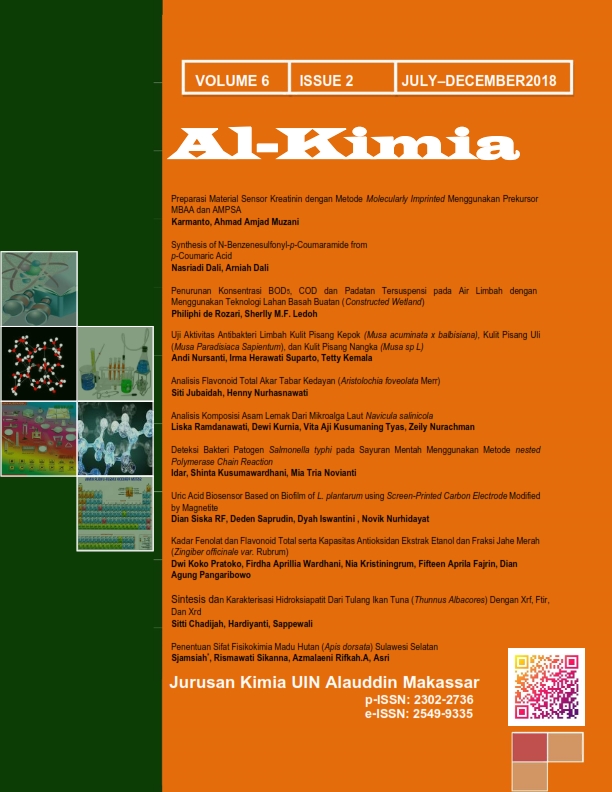Penurunan Konsentrasi BOD5, COD dan Padatan Tersuspensi pada Air Limbah dengan Menggunakan Teknologi Lahan Basah Buatan (Constructed Wetland)
Abstract
Constructed wetlands are a promising solution technology to effectively treat domestic wastewater in developing countries at low cost. This paper reports the findings of the effectiveness of sand planted with Thypa latifolia with variation of the length of outflow measured from the bottom of the media in removing BOD5, COD, and suspended solids. The experimental design consisted of 12 vertical flow (VF) mesocosms. There were 3 treatments and one control based on the with variation of the length of outflow measured from the bottom of the media (7, 14, and 21 cm). During the five months, the mesocosms were loaded with syntethic wastewater. The influent had a 2-day hydraulic retention time. Samples were monitored for BOD5, COD and TSS. The results showed the concetration of BOD5, COD and TSS reduced significantly after the wastewater were treated with constructed wetland systems. The trend showed that the constructed wetland systems planted with Thypa latifolia had a better performance in comparison with the control. There were no significant differences of BOD5 COD, and suspended solidoutflow among 7, 14 and 21 of constructed wetland systems. This indicated that the length of outflow measured from the bottom of the media did not influence the performance of constructed wetland systems in removing BOD5, COD and TSSDownloads
References
Abou-Elela, S. I., Golinielli, G., Abou-Taleb, E. M. & Hellal, M. S. (2013). Municipal wastewater treatment in horizontal and vertical flows constructed wetlands. Ecological Engineering, 61, 460-468.
APHA. (2005). Standard methods for the examination of water and wastewater, Washington DC, USA, APHA.
Greenway, M. (2005). The role of constructed wetlands in secondary effluent treatment and water reuse in subtropical and arid Australia. Ecological Engineering, 25, 501-509.
Kadlec, R. H., Roy, S. B., Munson, R. K., Charlton, S. & Brownlie, W. (2010). Water quality performance of treatment wetlands in the Imperial Valley, California. Ecological Engineering, 36, 1093-1107.
Kadlec, R. H. & Wallace, S. (2008). Treatment wetlands, CRC press.
Kansiime, F. & Maimuna, N. (1999). Wastewater treatment by a natural wetland: the Nakivubo swamp, Uganda, CRC Press.
Kantawanichkul, S., Somprasert, S., Aekasin, U. & Shutes, R. B. E. (2003). Treatment of agricultural wastewater in two experimental combined constructed wetland systems in a tropical climate. Water Science and Technology, 48, 199-205.
Kivaisi, A. K. (2001). The potential for constructed wetlands for wastewater treatment and reuse in developing countries: a review. Ecological Engineering, 16, 545-560.
Ran, N., Agami, M. & Oron, G. (2004). A pilot study of constructed wetlands using duckweed (Lemna gibba L.) for treatment of domestic primary effluent in Israel. Water Research, 38, 2241-2248.
Rousseau, D. (2005). Performance of constructed treatment wetlands: model-based evaluation and impact of operation and maintenance. Ghent University.
Shutes, R. B. E. (2001). Artificial wetlands and water quality improvement. Environment international, 26, 441-447.
Tegegne, B. M. (2008). AConstructedWetlandforWastewaterTreatmentwith EmphasisonOptimizationofNitrogenRemoval, M.Sc Thesis, UNESCO-IHE Delft, The Netherlands.
Vymazal, J. (2010). Constructed wetlands for wastewater treatment: five decades of experience†. Environmental science & technology, 45, 61-69.
Xu, D., Xu, J., Wu, J. & Muhammad, A. (2006). Studies on the phosphorus sorption capacity of substrates used in constructed wetland systems. Chemosphere, 63, 344-352.
Yang, Q., Chen, Z. H., Zhao, J. G. & Gu, B. H. (2007). Contaminant removal of domestic wastewater by constructed wetlands: effects of plant species. Journal of Integrative Plant Biology, 49, 437-446.
Copyright (c) 2018 Philiphi De Rozari, Sherlly M.F Ledoh

This work is licensed under a Creative Commons Attribution-NonCommercial-ShareAlike 4.0 International License.
Authors who publish with this journal agree to the following terms:
1) Authors retain copyright and grant the journal right of first publication with the work simultaneously licensed under a Creative Commons Attribution License that allows others to share the work with an acknowledgement of the work's authorship and initial publication in this journal.
2) Authors are able to enter into separate, additional contractual arrangements for the non-exclusive distribution of the journal's published version of the work (e.g., post it to an institutional repository or publish it in a book), with an acknowledgement of its initial publication in this journal.
3)Authors are permitted and encouraged to post their work online (e.g., in institutional repositories or on their website) prior to and during the submission process, as it can lead to productive exchanges, as well as earlier and greater citation of published work (See The Effect of Open Access).


